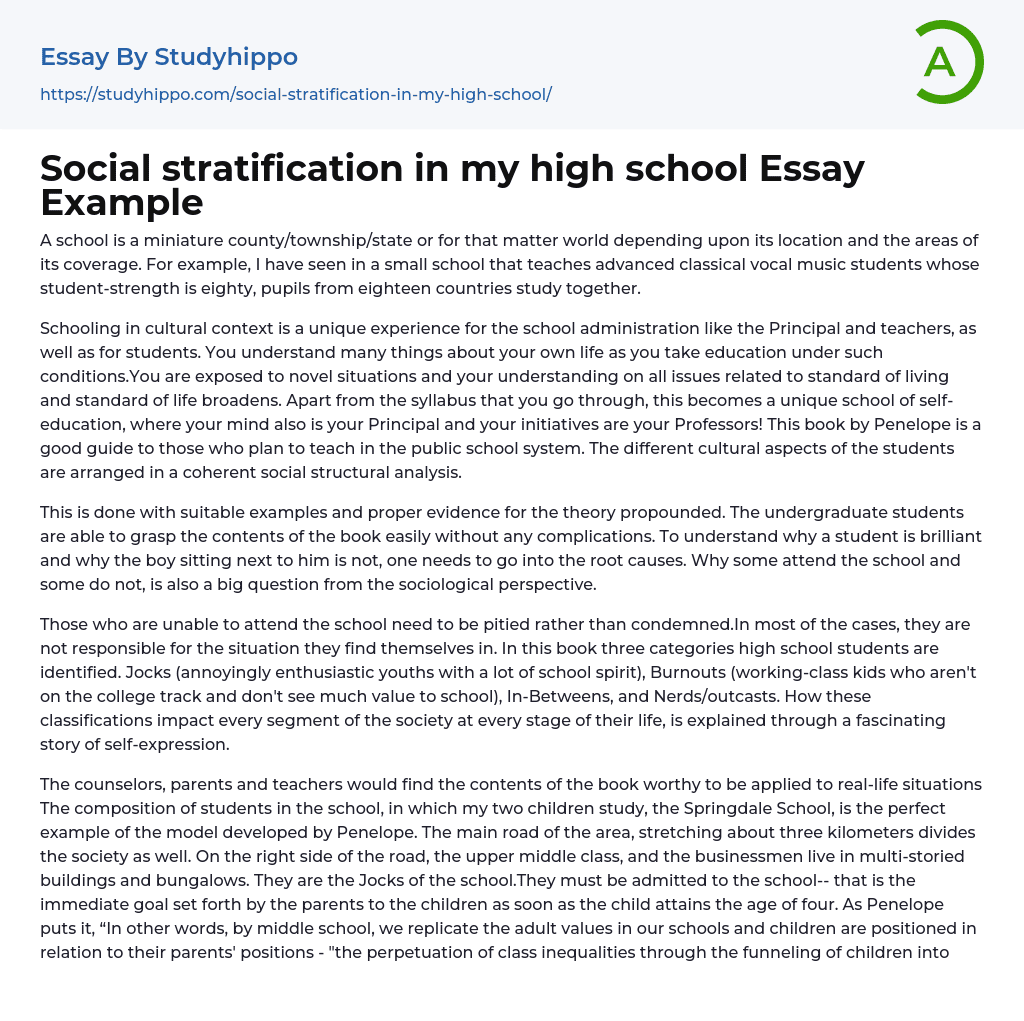A school is a miniature county/township/state or for that matter world depending upon its location and the areas of its coverage. For example, I have seen in a small school that teaches advanced classical vocal music students whose student-strength is eighty, pupils from eighteen countries study together.
Schooling in cultural context is a unique experience for the school administration like the Principal and teachers, as well as for students. You understand many things about your own life as you take education under such conditions.You are exposed to novel situations and your understanding on all issues related to standard of living and standard of life broadens. Apart from the syllabus that you go through, this becomes a unique school of self-education, where your mind also is your Principal and your initiatives are your Profess
...ors! This book by Penelope is a good guide to those who plan to teach in the public school system. The different cultural aspects of the students are arranged in a coherent social structural analysis.
This is done with suitable examples and proper evidence for the theory propounded. The undergraduate students are able to grasp the contents of the book easily without any complications. To understand why a student is brilliant and why the boy sitting next to him is not, one needs to go into the root causes. Why some attend the school and some do not, is also a big question from the sociological perspective.
Those who are unable to attend the school need to be pitied rather than condemned.In most of the cases, they are not responsible for the situation they find themselves in. In this book three categories high school students are
identified. Jocks (annoyingly enthusiastic youths with a lot of school spirit), Burnouts (working-class kids who aren't on the college track and don't see much value to school), In-Betweens, and Nerds/outcasts. How these classifications impact every segment of the society at every stage of their life, is explained through a fascinating story of self-expression.
The counselors, parents and teachers would find the contents of the book worthy to be applied to real-life situations The composition of students in the school, in which my two children study, the Springdale School, is the perfect example of the model developed by Penelope. The main road of the area, stretching about three kilometers divides the society as well. On the right side of the road, the upper middle class, and the businessmen live in multi-storied buildings and bungalows. They are the Jocks of the school.They must be admitted to the school-- that is the immediate goal set forth by the parents to the children as soon as the child attains the age of four. As Penelope puts it, “In other words, by middle school, we replicate the adult values in our schools and children are positioned in relation to their parents' positions - "the perpetuation of class inequalities through the funneling of children into their parents' place in society, and the enculturation of children into hierarchical social forms through explicit and implicit educational practices" (Penelope, 1989, Chapter, 7).
On the left side of the road, the families stay in slums and one-room tenements and their children are groomed to children of artisans, daily wage-earners, taxi drives, petty shop owners, etc. live. Their goals in life are not homogenous but heterogeneous, depending upon
the conditions of each family. The Burnout kids mostly have no fixed ambitions, their parents are not educated enough to counsel them, and they take life as it comes and adjust their careers according to the circumstances.
Conclusion:A class becomes the replica of the adult society outside. Perfect understanding and interaction between the two groups of students is not always feasible. Comparison of the standard of living and standard of life between the groups is unavoidable. The social tensions in the society are bound to find their expression within the class room. May not be in an aggravated form! Both the groups have the immense benefit by the daily process of student –teacher interaction between the students of various groups.
- Academia essays
- Higher Education essays
- Language Learning essays
- Studying Business essays
- Education System essays
- Study essays
- First Day of School essays
- Scholarship essays
- Pedagogy essays
- Curriculum essays
- Coursework essays
- Studying Abroad essays
- Philosophy of Education essays
- Purpose of Education essays
- Brainstorming essays
- Educational Goals essays
- Importance Of College Education essays
- Brown V Board of Education essays
- The Importance Of Higher Education essays
- Online Education Vs Traditional Education essays
- Academic And Career Goals essays
- Academic Integrity essays
- Brown Vs Board Of Education essays
- Distance learning essays
- Technology in Education essays
- Vocabulary essays
- Writing Experience essays
- Importance of Education essays
- Early Childhood Education essays
- Academic Degree essays
- Academic Dishonesty essays
- School Uniform essays
- Academic writing essays
- Cheating essays
- Bachelor's Degree essays
- MBA essays
- College Life essays
- Grade essays
- Diploma essays
- Phonology essays
- Sentence essays
- Filipino Language essays
- Pragmatics essays
- Millennium Development Goals essays
- History Of Education essays
- Graduate School essays
- Middle School essays
- School essays
- Special Education essays
- University essays




